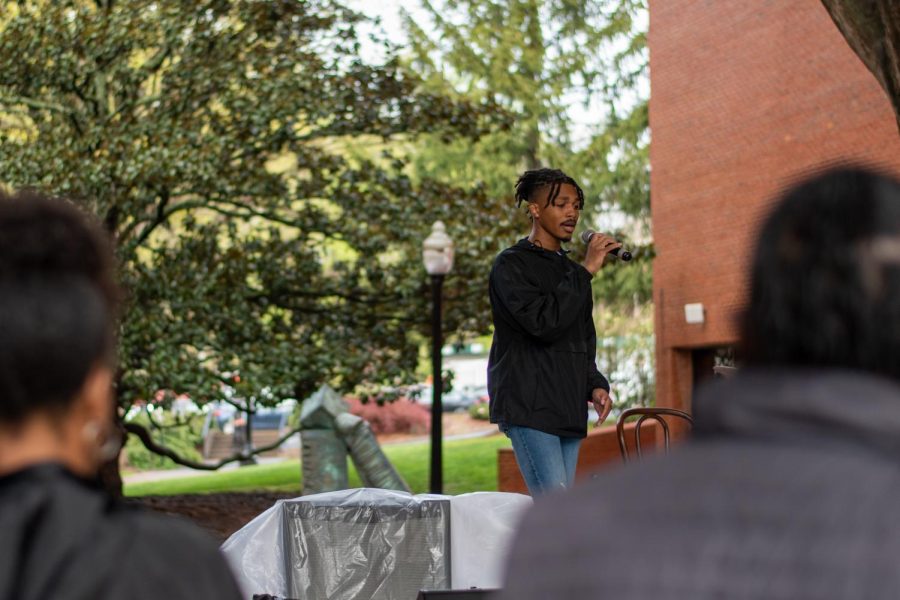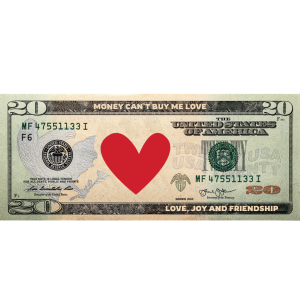Arts and environment take center stage at Wakeville
A day of bonding, arts, and beyond all else – sustainability
Armon White (’23) performs at Wakeville. The festival placed an emphasis on both the arts and sustainability.
April 18, 2023
On April 1, history was made at Wake Forest University — and this is no April Fools joke! Students from a variety of artistic communities and disciplines across campus came together to host Wake Forest’s first annual interdisciplinary arts festival with more than 100 participating artists, 12 different art disciplines and six exciting hours of local — and better yet, sustainable — entertainment.
Wakeville student organizer, Roscoe Bell, is a senior who has been planning Wakeville for the past year. Bell described Wakeville as an opportunity to experience the arts in a “Sam’s Club or a Costco way — with little art samples and taste-testers.”
“The inspiration for the event was to showcase hidden talent across campus,” Bell said. “If you’re not in, let’s say music, there is not necessarily a platform on campus for musicians to showcase their work. A big inspiration for this festival is to allow anyone with an interest in the arts to participate.”
Through Wakeville, all students were invited to participate and show off their skills, offering an opportunity for artists of all kinds to communicate and collaborate. More than three galleries and auditoriums were filled with student-made art, from the visual arts to film to theater to music.
Perhaps even more impressive than the art itself is the sustainable lens through which the festival was approached. Bell stressed that the Wakeville board of student directors took painstaking measures to ensure that the festival was sustainably optimized and environmentally mindful.
“We really made an effort to minimize paper waste,” Bell said. “We found that it was easier and more accessible for students to use QR codes, instead of brochures or pamphlets, and had a lot of success promoting ourselves through these sustainable means.”
Gretchen Castelloe, the sustainability advisor for Wakeville, considers the event’s sustainable advertising to be a hard-earned success, the fruit of labor and love.
“The more we bought and the more resources we consumed, the less sustainable we would be,” Costelloe said. “It came to a matter of what we considered to be more important, being sustainable or spreading awareness about the event. It was a gamble of sustainability and the success of Wakeville itself. To overcome this, we inserted QR codes into all of our posters and banners, so they could be reused for years to come.”
In addition to the advertising, sustainability appeared as a recurring theme throughout the event itself, underscoring the importance of sustainability in our day-to-day practices.
“Everything produced for Wakeville was created with the intention of being reusable for years to come, such as the banners, flags, stage set-ups, tables and signage,” Bell said. “Waste that could not be reused will be recycled.”
Castelloe also echoes these notions of responsible consumption, stressing that the intentional use of the planet’s resources was a crucial consideration in the planning of this large-scale event.
“Our goal was to be sustainable consumers. In terms of equipment, we looked for rentals rather than simply buying it outright,” Costelloe said. “A lot of materials used in Wakeville come from rented or found materials. The stage, bounce house and sound equipment were all rented. Using Scales as the venue was both eco-friendly and budget-friendly, as it already had theaters and spaces ready with materials needed to put on shows, such as lighting, sound equipment and gallery space.”
Additionally, tables and displays were set up throughout the event that were advocating for sustainable practices and promoting sustainable businesses. Castelloe remarked that these tables were especially important to her.
“Because of my connections across campus, I had a good platform to ensure that sustainable organizations and businesses had tables and opportunities to advertise their messages about sustainability and its function in society today,” Costelloe said.
One table was the sustainable thrift store pop-up, about which Castelloe spoke on her philosophy behind it: “We all had a bunch of leftover clothes from the fall and spring semesters. We were going to donate it to Goodwill anyway, so we decided to give people on campus the opportunity to look through it first.”
By welcoming students across disciplines to Wake Forest’s own world of the arts, arts and non-arts students alike were offered an opportunity to celebrate the hidden passions of others and discover new passions of their own. The initial goal of the festival was to connect the various art departments at Wake to one another and the rest of campus, but it ended up accomplishing much more. Wakeville nurtured artistic passions while promoting sustainable practices, setting a promising and admirable precedent for years to come.














